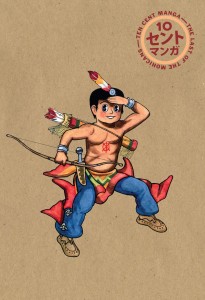By Shigeru Suguira. Released in Japan initially by Shueisha; this updated edition was released by Shobunsha. Released in North America by PictureBox.
Wow. I had heard that this author was a bit surreal, so I went into this thinking I was prepared, but I was not remotely prepared. I’m not entirely sure that this manga can be read, per se. It’s an experience, almost like going to an interactive art show or something. Each page led to a new expression on my face: awe, bewilderment, sometimes staring blankly while saying “Really?” There is a story to tell, and it flows pretty well, but I’ll be honest, there’s nothing here regarding plot and characterization to talk about. Not that this is a bad thing. I found reading this to be very sensory, and absolutely would recommend it to other hardcore manga fans.
Technically, this is an adaptation of James Fenimore Cooper’s Leatherstocking Tale, and the basic framework does sort of follow the plot. This doesn’t take place in a realistic world, however. This is the world of Wild West movies, where the East Coast can have huge mesa and rocky cliffs. It’s also very much the world of 50s comic books and strips. Photorealistic serious-minded Indians stand together with some of the goofiest faces you’ve seen this side of Doraemon. And it’s in your face the whole time – there’s no way you can try to work around it. Because this is also very comedic, despite its presence. There’s lots of fourth-wall breaking, and silly gags, and dumb Indians doing dumb things. It’s fun, but loose – one feels that if you take one wrong step along the way, you’ll end up in a place no reader has gone before.
According to the very welcome essays at the end of this book by translator Ryan Holmberg, this is how Sugiura’s style worked in general, particularly in the 60s and 70s. This edition dates from 1973-74, and is an update of the original 1953 edition. Reading the essays made me realize what my mind had been struggling with the entire time I read the manga – it felt like a collage. Pastiche isn’t quite right, because it doesn’t explain the way that the work gives a sense that anything can be pasted in from anywhere as you go. And so the two military daughters who need to be rescued are straight out of a romance comic-book and the villain of the piece is drawn completely straight, yet one of the guards is Oliver Hardy, and Wimpy from Popeye is the chef. The band Negativland once called this kind of approach culture jamming, and that’s what we see here – American and Japanese influence all thrown into one glorious canvas.
This is not the sort of manga I would recommend to any casual manga reader, nor do I think it would be a good present for kids, even if it was meant for young children in Japan. The content pretty much deals with the old, slightly racist way that Hollywood and comic books dealt with Indians, though honestly it’s much better than other contemporary works could be. But for those who really love something different in their manga, or for scholars, this is a real treat. It’s just about the right length – I’m not sure I could have taken more than the 114 pages it turned out to be, mostly as reading it can be a bit exhausting. For those who like a challenge, or art lovers, or even folks who enjoy slapstick comedy, give Last of the Mohicans a try. It’s like a yaminabe – you never quite know what ingredient will come out next.


[…] Hikaru (The Comic Book Bin) Jocelyne Allen on Keimusho no Naka (Brain Vs. Book) Sean Gaffney on Last of the Mohicans (A Case Suitable for Treatment) Johanna Draper Carlson on vol. 6 of Limit (Comics Worth Reading) […]